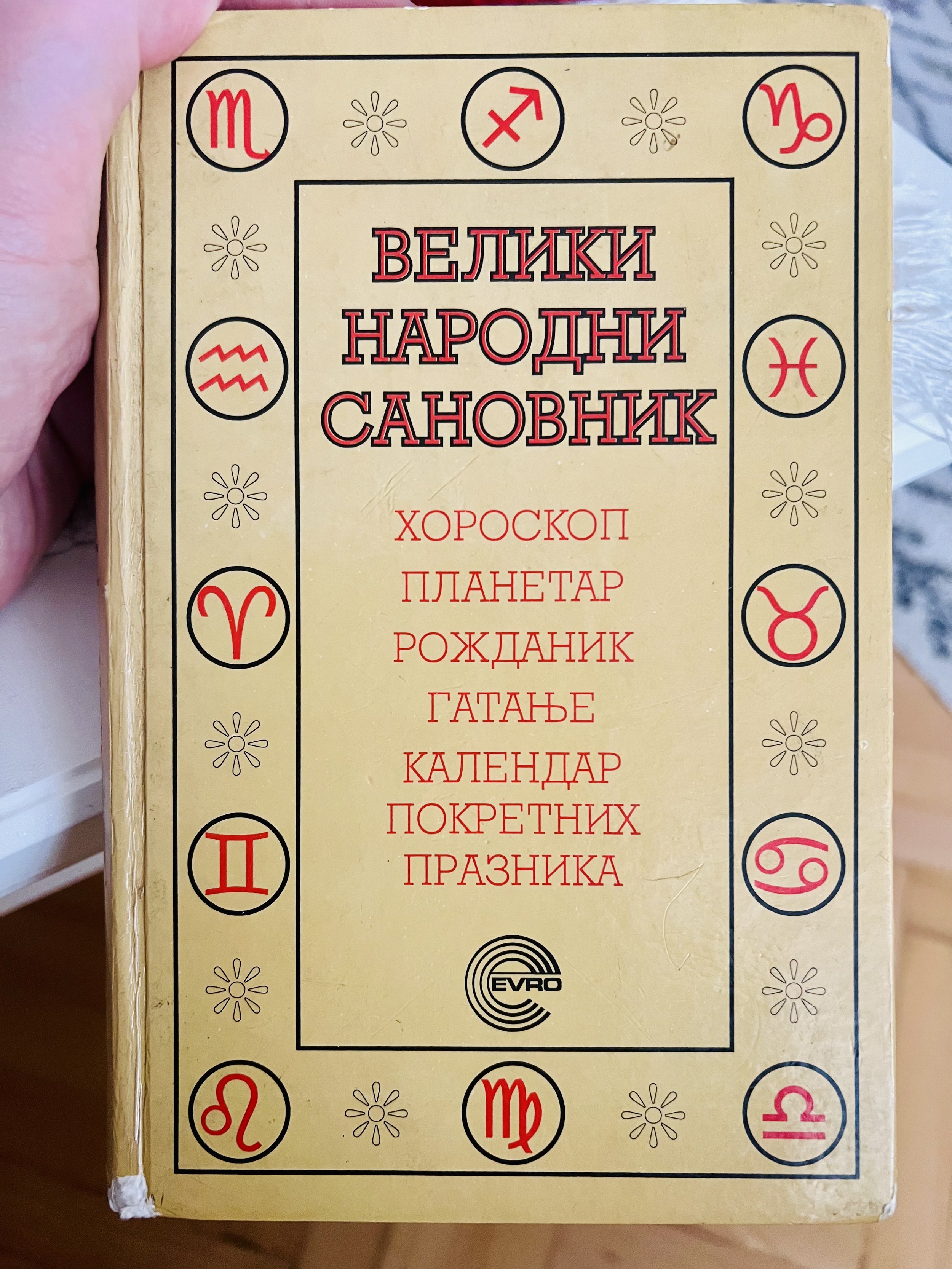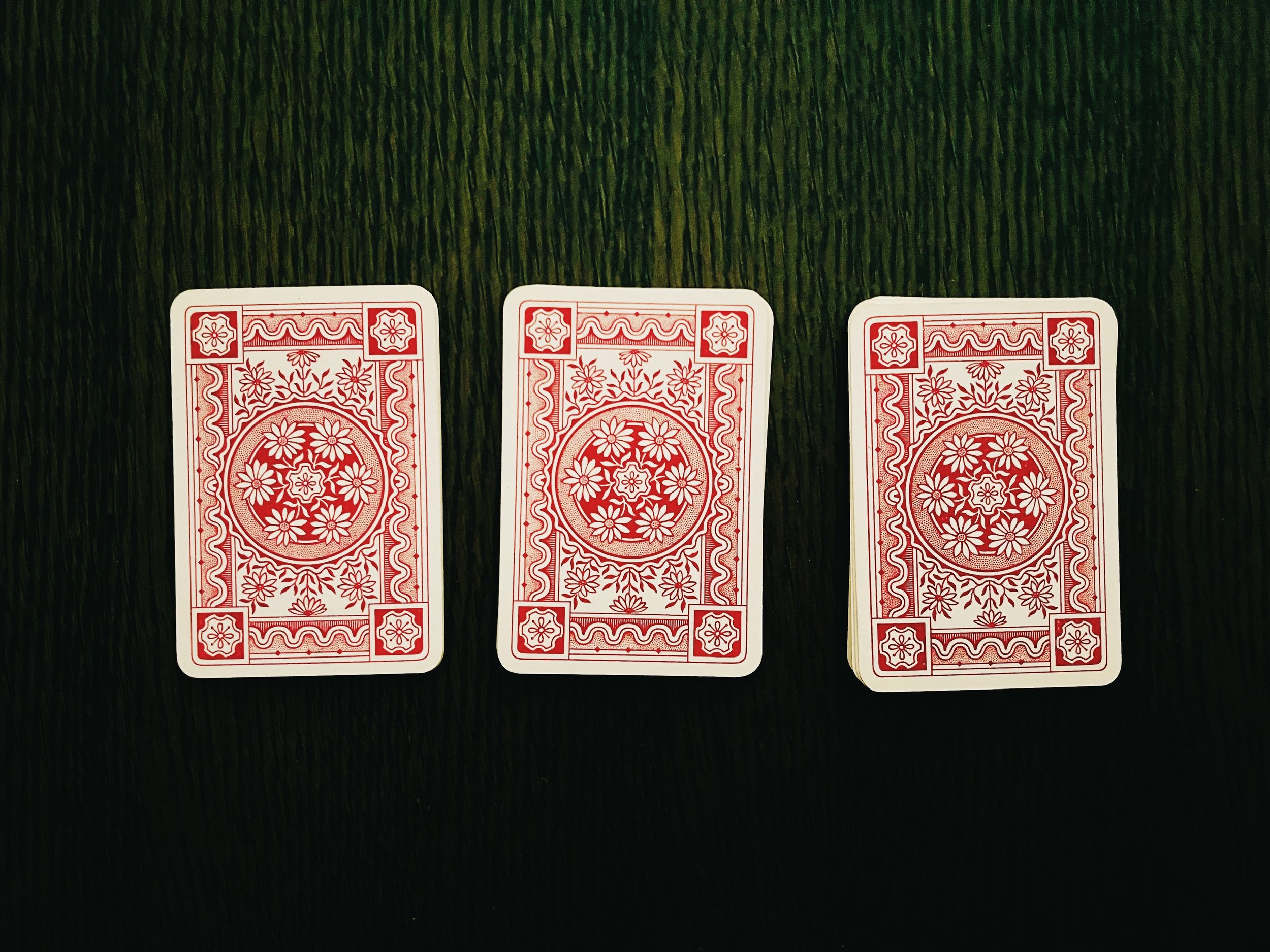Grand Tableau Reading Method From The Serbian “Great Folk Dream Book”
From the vast occult knowledge circling in my mother’s family, very little was to be found in writing. There is only one incantation my grandmother has ever written down, and I still keep it, even though it is falling apart. The same went for fortunetelling. There was only one book on the subject that I can remember: The Great Folk Dream Book, or Veliki Narodni Sanovnik in Serbian.
The book’s origin is somewhat older. I believe the first edition was printed at the end of the 19th century, and through the years it bore different names: Dream Book, Folk Dream Book, Great Eternal Calender, etc. It contains a dream lexicon with folk interpretations, the basics of astrology, sun signs, planets, and planetary hours, an introduction to chiromancy, but also, a section on reading playing cards. This section contained a rather weird petit-bourgeois moral story approving cartomancy, a list of meanings for all 52 cards, meanings of card groups, and a general reading method for a reduced deck of 32 cards, plus a few short examples of reading for wishes which are not worth mentioning.
1997 edition of the Great Folk Dream Book in Serbian.
This book was my first literary peek into cartomantic methods, and of course, I absorbed all of it. Looking at the cultural context, the method offered in the book worked very well. It presupposes that the querent comes to us without any question or context, and this is what often happens in our nick of the woods. I rarely ever practice doing general readings nowadays, so when my family and friends from former Yugoslavia come to me asking to read their cards, they get flabbergasted when I answer with “What is your precise question?” As it seems, there is a long cultural tradition of coming to a fortuneteller without any questions, and apparently, this serves two points: firstly, it presupposes that the cartomancer is always already psychic and that the cards are just a channeling tool; secondly, it fosters the folk belief that one’s wishes or plans should never be said out loud, “lest the evil hears it”. So my question is almost always answered with “Should I say it out loud?!”, to which I can only roll my eyes and tell them to either tell me why they came or hit the road. Nevertheless, we can entertain this notion of no context, and this method offers a fitting strategy.
The Method
To use this method, you will need a Piquet deck of 32 cards: 7s, 8s, 9s, 10s, Jacks, Queens, Kings, and Aces. The primary goal is to create a tableau of 28 cards. But first, you need to determine the querent’s significator: blond people get Hearts; brunettes get Clubs; gingers, gray-haired, and colored-hair people get Diamonds; black-haired people get Spades. Women are Queens, Men are Kings, and Children are Jacks. Some other areas of life can get significators, too: Ace of Hearts stands for their home, Ace of Diamonds for a contract, a paper, a letter, or an engagement ring, while 9 of Hearts can stand for their heart’s desire - if this card appears in the tableau, they can make a wish. A King or a Queen of the same suit stands for their partner.
After you determine the significator, you shuffle the cards and cut them in one swoop, from left to right, creating three piles (you can refer to my YouTube video for details):
You will then proceed with turning over the piles one by one and reading the last three cards from the first pile, the last 4 cards from the second pile, and the last 2 cards from the third pile. This will provide you with the context, or the basis for the entire reading. You need to read all the cards together and connect them into a cohesive storyline. Do not mess with the order of the cards. They need to stay exactly as they were. After you create a base storyline, put the cards back in reverse order: the first pile goes on top of the second pile, and both of them go on top of the third. Now you can proceed with creating a tableau containing 4 rows of 7 cards:
You should now have 4 remaining cards. You can set them aside for later. Then, locate the significator in the tableau. In this case, we will go with the Queen of Hearts. If the significator does not appear, you can use a Jack of the same suit, or Ace of Hearts which stands for your home. If this happens, it indicates that the querent is not an active player in their current affairs and that they are subject to external influences. If the significator does appear, we look first at its position: if they are on top, the querent seems to have a good hold of their life at the moment; if they appear on the bottom, they are overloaded with the situation, as if they are carrying everything on their head.
Then you can proceed with reading the cards in the immediate surroundings of the significator. The card above it denotes the querent’s thoughts; the card below it indicates what the querent controls; cards to the left indicate the past; cards to the right indicate the future. For instance, the Queen of Hearts has a change in finances on her mind (9 of Diamonds), as she suffers both mentally and physically because of it (card flanked by 7 of Hearts and 10 of Clubs).
You can now take a look at the other significators (home, relationship, work, etc.) and read their surrounding cards. If you wish, you can also use the Lenormand Grand Tableau method of intersecting the significators by drawing a horizontal line from the querent’s significator, and a vertical line from any other significator and see in which card they intersect. This will tell something about their relationship. You never interpret the entire tableau - only the focus points. You need to bear the base story in your head the entire time, as it provides a context for what you see in the tableau. After you are done with the interpretation, you proceed to the final stage of the reading, where you will cover the cards of interest with the remaining 4 cards:
The querent needs to indicate in which areas they want more clarity: For the money, we can cover the 10 diamonds, for the partner a King or a Queen of the same suit, or make a wish if the 9 of Hearts appears in the tableau, in which case a cover card will reveal if the wish will come true or not. In other cases, cover cards modify the significators.
This concludes the general reading. Needless to say, you can always use this method and read the tableau as you see fit. I cast this tableau for particular questions, in which case we can safely skip the context creation part and proceed directly with creating the tableau after only one cut. Feel free to play with it. To paraphrase Camelia Elias: the method does not rule over you - you rule over the method.
To see the opening process in action, feel free to take a look at my YouTube video on the subject:
If reading a Piquet deck of 32 cards is new to you, Camelia Elias has a great article on the subject, available on her Taroflexions blog: The Logic of Piquet Decks.







